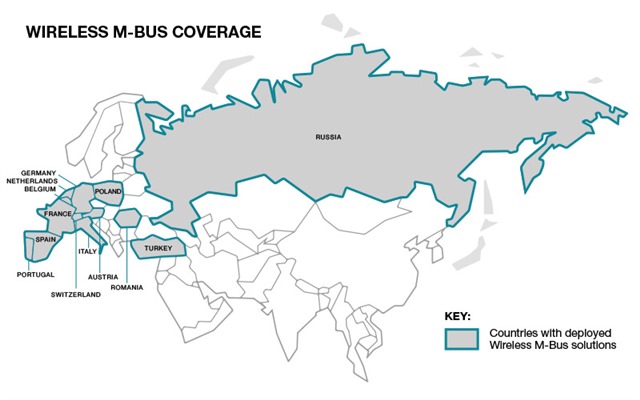SSZT149 july 2021 CC1310 , CC1350
One of the top worldwide trends in metering is to add connectivity to the meter. This allows for efficient readouts, over the air updates, and quick connectivity to your phone. In large buildings with various tenants, you have multiple meters that need to be read monthly. If all these meters are connected, pulling data from them is as simple as walking up to a data collector and performing a quick readout. This saves time and money for the electricity companies.
However, designing wireless connectivity into your flow or electricity meter, can be a bit overwhelming. If you just want to wirelessly read data off your meter and you perform a quick web search on how to implement this, you are immediately flooded with several options of range, throughput, and protocols. Where do you start?
In order to choose amongst the various protocols, you need an understanding of where your meter will be installed. Will it be in a basement or alleyway? Do you need coverage for a house or an apartment building? Where will you place the data collector or gateway? If the meter needs to connect to a data collector or gateway, that means transmitting through obstacles such as concrete walls and multiple floors over long distances – a harsh environment for wireless connectivity. One technology is specifically designed for this challenge: Sub-1 GHz.
Another challenge when designing a meter (depending on its deployment) is that it will most likely be read by multiple energy companies, in multiple cities, in multiple countries, all with their own rules and regulations. It can be confusing for a designer who is trying to determine the frequency needed for their region in Europe, what standards are available for their application and even where to start. Wireless M-Bus helps alleviate this confusion by creating a Sub-1 GHz standard for European countries.
What Is Wireless M-Bus?
Various Modes
If you don’t need a high data rate, but your network is spread over a wide area, then the solution is a narrowband network on 169MHz. Narrowband (N) mode is known for long range, tripling the areas covered by S, T and C modes. The other four modes – R, F, P and Q – are less common.
Available Application Profiles
Dutch Smart Meter Requirements (DSMR) is another application layer-focused standard. DSMR also operates in the 868-MHz band and has several focused companion guides for various flow and electricity meters. DSMR is typically deployed in meters in the Netherlands.
Not all profiles are based on 868 MHz: Committee Italian Gaz (CIG) and Gaz Reseau Distribution France (GrDF) use N mode on 169 MHz. The CIG profile is focused in Italy, allows for +27 dBm of output power, and follows Ente Nazionale Italiano di Unificazione (UNI) technical specification (TS) 11291. The French-based GrDF has set the toughest wM-Bus requirements, requiring sensitivity and blocking beyond what EN 13757-4 specifies.
An interesting adaption of the GrDF profile is within the Wize Alliance, which uses the 169-MHz profile to go beyond meters and target smart city applications throughout Europe and Africa.
wM-Bus Brings History to Sub-1 GHz
Where Should You Start with wM-Bus?
To get a head start on software, TI provides a royalty-free software stack based on the CC1310 platform. TI’s wM-Bus stack is deployed in over 10 countries throughout Europe. For stack support, TI has an application team in Oslo, Norway, that works closely with Stackforce GmBH for stack customization and porting to specific hardware platforms.
While TI has many Sub-1 GHz TI designs for smart grid applications, a great place to start is the Ultra-Low-Power Water-Flow Measurement for AMR Reference Design, which demonstrates a fully tested single-chip solution based on the CC1312.
